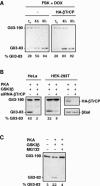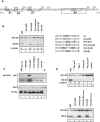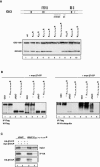Multisite protein kinase A and glycogen synthase kinase 3beta phosphorylation leads to Gli3 ubiquitination by SCFbetaTrCP
- PMID: 16705181
- PMCID: PMC1489100
- DOI: 10.1128/MCB.02183-05
Multisite protein kinase A and glycogen synthase kinase 3beta phosphorylation leads to Gli3 ubiquitination by SCFbetaTrCP
Abstract
Gli3 is a zinc finger transcription factor proteolytically processed into a truncated repressor lacking C-terminal activation domains. Gli3 processing is stimulated by protein kinase A (PKA) and inhibited by Hedgehog signaling, a major signaling pathway in vertebrate development and disease. We show here that multisite glycogen synthase kinase 3beta (GSK3beta) phosphorylation and ubiquitination by SCFbetaTrCP are required for Gli3 processing. We identified multiple betaTrCP-binding sites related to the DSGX2-4S motif in Gli3, which are intertwined with PKA and GSK3beta sites, and SCFbetaTrCP target lysines that are essential for processing. Our results support a simple model whereby PKA triggers a cascade of Gli3 phosphorylation by GSK3beta and CK1 that leads to direct betaTrCP binding and ubiquitination by SCFbetaTrCP. Binding of betaTrCP to Gli3 N- and C-terminal domains lacking DSGX2-4S-related motifs was also observed, which could reflect indirect interaction via other components of Hedgehog signaling, such as the tumor suppressor Sufu. Gli3 therefore joins a small set of transcription factors whose processing is regulated by the ubiquitin-proteasome pathway. Our study sheds light on the role of PKA phosphorylation in Gli3 processing and will help to analyze how dose-dependent tuning of Gli3 processing is achieved by Hedgehog signaling.
Figures









Similar articles
-
Dual Phosphorylation of suppressor of fused (Sufu) by PKA and GSK3beta regulates its stability and localization in the primary cilium.J Biol Chem. 2011 Apr 15;286(15):13502-11. doi: 10.1074/jbc.M110.217604. Epub 2011 Feb 11. J Biol Chem. 2011. PMID: 21317289 Free PMC article.
-
Evidence for the direct involvement of {beta}TrCP in Gli3 protein processing.Proc Natl Acad Sci U S A. 2006 Jan 3;103(1):33-8. doi: 10.1073/pnas.0509927103. Epub 2005 Dec 21. Proc Natl Acad Sci U S A. 2006. PMID: 16371461 Free PMC article.
-
Sufu recruits GSK3beta for efficient processing of Gli3.Biochem Biophys Res Commun. 2009 Sep 25;387(3):569-74. doi: 10.1016/j.bbrc.2009.07.087. Epub 2009 Jul 19. Biochem Biophys Res Commun. 2009. PMID: 19622347
-
Many faces and functions of GSKIP: a temporospatial regulation view.Cell Signal. 2022 Sep;97:110391. doi: 10.1016/j.cellsig.2022.110391. Epub 2022 Jun 18. Cell Signal. 2022. PMID: 35728705 Review.
-
[Molecular mechanisms of axon degeneration regulated by the ubiquitin proteasome system].Seikagaku. 2012 Jun;84(6):463-71. Seikagaku. 2012. PMID: 22844776 Review. Japanese. No abstract available.
Cited by
-
The hedgehog pathway in triple-negative breast cancer.Cancer Med. 2016 Oct;5(10):2989-3006. doi: 10.1002/cam4.833. Epub 2016 Aug 18. Cancer Med. 2016. PMID: 27539549 Free PMC article. Review.
-
Gli Phosphorylation Code in Hedgehog Signal Transduction.Front Cell Dev Biol. 2022 Jan 25;10:846927. doi: 10.3389/fcell.2022.846927. eCollection 2022. Front Cell Dev Biol. 2022. PMID: 35186941 Free PMC article. Review.
-
A three-part signal governs differential processing of Gli1 and Gli3 proteins by the proteasome.J Biol Chem. 2011 Nov 11;286(45):39051-8. doi: 10.1074/jbc.M111.274993. Epub 2011 Sep 15. J Biol Chem. 2011. PMID: 21921029 Free PMC article.
-
Dual Phosphorylation of suppressor of fused (Sufu) by PKA and GSK3beta regulates its stability and localization in the primary cilium.J Biol Chem. 2011 Apr 15;286(15):13502-11. doi: 10.1074/jbc.M110.217604. Epub 2011 Feb 11. J Biol Chem. 2011. PMID: 21317289 Free PMC article.
-
The E3 ubiquitin ligase Siah1 regulates adrenal gland organization and aldosterone secretion.JCI Insight. 2017 Dec 7;2(23):e97128. doi: 10.1172/jci.insight.97128. JCI Insight. 2017. PMID: 29212953 Free PMC article.
References
-
- Bai, C. B., D. Stephen, and A. L. Joyner. 2004. All mouse ventral spinal cord patterning by hedgehog is Gli dependent and involves an activator function of Gli3. Dev. Cell 6:103-115. - PubMed
-
- Busino, L., M. Donzelli, M. Chiesa, D. Guardavaccaro, D. Ganoth, N. V. Dorrello, A. Hershko, M. Pagano, and G. F. Draetta. 2003. Degradation of Cdc25A by beta-TrCP during S phase and in response to DNA damage. Nature 426:87-91. - PubMed
-
- Chen, C. H., D. P. von Kessler, W. Park, B. Wang, Y. Ma, and P. A. Beachy. 1999. Nuclear trafficking of Cubitus interruptus in the transcriptional regulation of Hedgehog target gene expression. Cell 98:305-316. - PubMed
Publication types
MeSH terms
Substances
LinkOut - more resources
Full Text Sources
Other Literature Sources
Molecular Biology Databases
Research Materials
Miscellaneous
